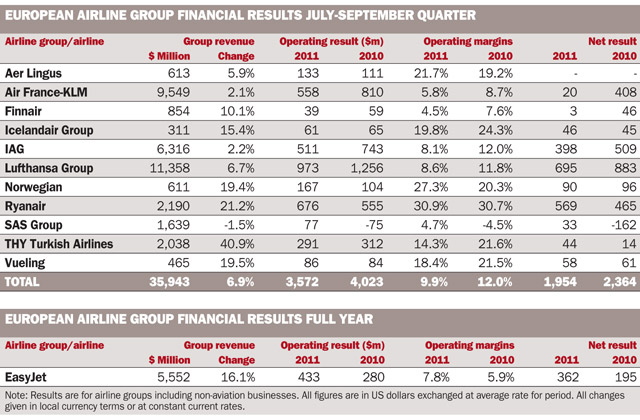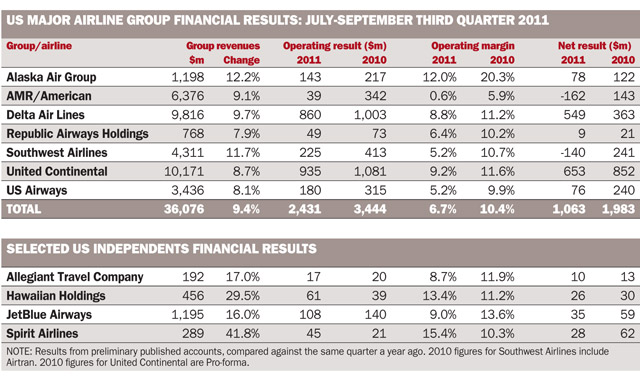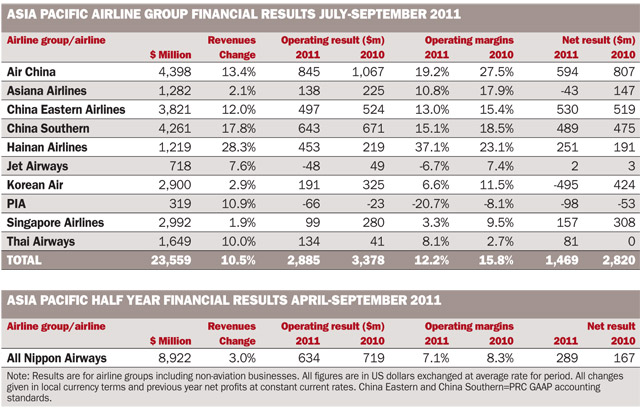After battling to retain their hard-won profitability in the second quarter, results for the 2011 third quarter proved to be a further challenge for airlines. Fuel costs rose as hedging protection began to unwind, while economic uncertainty deepened. While passenger traffic continued to grow, freight activity has already stagnated.
The result was an erosion of some airlines profitability. Collective operating profits among US majors and large independent operators were down by around $1 billion to $2.66 billion.
In Europe and the Asia-Pacific region, operating profits for selected carriers fell by around half a billion to $3.5 billion and $2.9 billion, respectively - though at a net level, collective Asia-Pacific carrier profits were halved.
Even Emirates returned to more mundane profit growth in the first half as a result of higher fuel costs and the political turmoil in north Africa and the Middle East. Its first-half net profits fell almost three-quarters to UAE dirham (Dh) 827 million ($225 million) for the six months ending September 2011. This compares to the Dh3.4 billion net profit it made during the same period last year - itself a quadrupling of the 2009 first-half profit.
EUROPEAN CAPACITY PULL
For European airlines, caught in the grips of the continued eurozone debt crisis, the third quarter was going to be tough - especially after their 2011 second-quarter figures compared favourably against the ash-cloud-disrupted second quarter of 2010.
Europe's big three network groupings, Lufthansa, Air France-KLM and International Airlines Group, all saw profits slip in the quarter
 |
|---|
Spinetta, who has returned as chairman and chief executive while the group pushes back its holding structure plans into 2013, says cost savings and debt reduction need to increase at Air France-KLM to re-establish the competitiveness of the group. Spinetta describes the position as difficult.
"It's not a disastrous situation, but we need to take action," he says. As part of Air France-KLM's bid to reduce unit costs, the group will restructure its short- and medium-haul operations, including Air France's Regional subsidiary.
Although details of the restructure will not be announced until the first quarter of 2012, Spinetta says the restructure would go much further than the "New European Offer" business model launched in April 2010 and Air France's programme to establish regional bases.
Spinetta was called upon after Air France-KLM Group chief executive Pierre-Henri Gourgeon resigned in October. Asked if he was concerned with tarnishing his reputation as one of the group's founders by coming back at such a difficult time, he said he was not worried about his image.
"You may think I made a mistake coming back, we will see," he says.
With profits cut and the prospect of a difficult winter and year ahead, eyes among many European carriers have turned to capacity to help counter the kicking-in of rising fuel cost and deteriorating markets.
For example, Lufthansa chief financial officer Stephan Gemkow says for the year ahead, the company is preparing for slowing growth in passenger and freight traffic. The Star Alliance carrier had already scaled back winter capacity and now plans to cut passenger traffic growth for next year down to 3% from 9% .
Lufthansa reported operating profits over the first nine months down only 5%, but says much of this was due to the positive first half of the year. The carrier is forecasting full-year operating profits in the upper hundred-million euro range.
"We are still talking about a very substantial operating profit," says Gemkow, but adds fluctuations in booking figures, high fuel prices and the abrupt imposition of the night-flight ban at Frankfurt airport make it difficult to give a more precise forecast.
British Airways and Iberia parent International Airlines Group (IAG), which saw its third-quarter operating profits cut by a third, still sees an improved operating performances for the full year at around double the €225 million ($354 million) the group made last year. This is based on only breaking-even in the fourth quarter, however.
IAG also stresses it is ready to adjust capacity if there is a sustained drop in demand. "We are looking at very low capacity growth of 2.5% in 2012, and it would have been lower than that but for the acquisition of six slot pairs from BMI," says IAG chief executive Willie Walsh.
"Our growth plan for 2012 is very moderate and conservative. But clearly we have considerable flexibility should we need to use it to adjust that capacity in line with the demand."
Walsh also says forward bookings appear solid for the next three months. "There is some change in behaviour for corporate travel policies for short-haul premium as we have come into the fourth quarter," he says.
"But looking at the current booking trend, we haven't seen any real change in booking patterns. Long-haul premium was positive in October and we expect it to be positive in November and December."
The region's low-cost carriers meanwhile enjoyed stable or improved profits for the quarter. Ryanair was among the most bullish. It not only saw profits for the three months to September 2011 grow by 20%, but also raised its full-year profit forecast 10% to €440 million. Much of this came off the back of better than expected yield growth of 13% in the first half and projected increases of 14% over the rest of the year.
While chief executive Michael O'Leary kept the caveat of actual fourth-quarter yield development in its projection - noting it has little visibility for January to March next year - he says much of the yield improvement reflects its slower growth this winter.
"As we slow down our rate of growth, you see a better outcome on yields," he says. "Two years ago, average fares were £30 ($48). That has risen to £40 and that is helping us to pay for the [higher] fuel charges."
ROBUST VIEW FROM US CARRIERS
US carriers were largely successful in their efforts to cover rising fuel costs during the third quarter as strong demand allowed for pricing traction to help beat back fuel's wrath.
Despite higher fuel expenses year on year all the US majors with the exception of American Airlines turned a profit.
 |
|---|
Carrier chief executive Dave Barger cites the carrier's revenue diversification during travel shoulder periods as one of the drivers of JetBlue's ability to remain profitable.
The settling of unfavourable fuel hedges drove Southwest to a rare $140 million net loss, but the carrier's revenues jumped by a third year to $4.3 billion, with two-thirds of the growth attributable to a contribution from AirTran. Southwest closed the AirTran acquisition in May.
Despite posting a third-quarter loss, chief executive Gary Kelly remains encouraged by customer travel trends. "We saw no weakening in overall demand," says Kelly. "And I think perhaps more importantly, we saw no softening in business travel."
Executives at other carriers echo Kelly's conclusion of demand remaining robust.
US Airways saw growth in both passenger and leisure demand during the third quarter, and carrier president Scott Kirby sees no signs of demand strength diminishing. He says that during the second quarter "we were cautiously optimistic that June represented the low point for industry revenue, and that appears to be the case".
Many believe that structural changes in the US airline industry, including capacity discipline, consolidation and carriers stopping their fight for market share, have positioned them to defy historical trends and post profits next year. Analysts at JP Morgan have declared they "continue to model for the unprecedented profitable recession".
Noting historically airline executive teams have largely modelled for "sunny days" without embracing a downside scenario in their business plans, "capacity today continues to flow out of the system rather than in".
Another structural shift those analysts see is a correlation between oil and economic output "unlike anything the industry has ever witnessed". They believe carriers have a natural hedge from parallel rises in gross domestic product and increasing fuel costs. The JP Morgan thesis suggests the natural hedge created by that correlation "suggests much tamer profit gyrations" rather than dramatic swings of operating margins from a negative 9% to 11%.
They envision a scenario of carriers settling into a "6-9% margin band throughout an entire cycle".
In the meantime, US carrier bullishness on passenger demand continues unabated. Noting that many industry watchers are "looking for the canary in the coal mine that indicates airline revenues are turning down, we just don't see it yet", declares Kirby of US Airways.
"In fact, it is quite the opposite... all the data we have leaves us optimistic about the demand outlook,e_SDRq he adds.
ASIA EYES LONG-TERM GAINS
Asia-Pacific carriers suffered some high-profile cuts in profits during the quarter and in some cases losses.
This reflects increased fuel costs, but also Asian carrier's relatively higher exposure to cargo - a sector in which traffic growth has plateaued since the summer.
 |
|---|
Much of the attention in the quarter has centred on India's carriers. Jet Airways slipped to a group net loss of more than Indian rupees (Rs) 8 billion ($157 million) for its second quarter as a sharp jump in fuel costs and a foreign exchange hit took a toll.
"Abnormally high fuel costs, a low fares scenario induced by demand-supply imbalance, together with a depreciating rupee versus the US dollar and fare cuts, coupled with the second quarter traditionally being considered the lean season, have all collectively impacted the second-quarter performance," says Jet Airways chief executive Nikos Kardassis.
Net losses at Kingfisher Airlines more than doubled to Rs4.69 billion in its fiscal second quarter, driven by fuel costs up by 70% in the quarter. The latter has been talking to banks to secure a higher credit limit for its day-to-day working capital.
Kingfisher chief executive Sanjay Aggarwal says the airline had asked for bank limits to be raised because of a spike in operating costs, reflecting higher fuel prices and currency changes.
But the longer-term outlook remains strong. Asia's main airline association expects carriers to continue growing in 2012 despite the difficult third quarter and concerns about economic uncertainties in Europe and the US.
The optimism is reflected in airlines' ambitious fleet expansion plans and the establishment of a number of new carriers of varying business models, says the director-general of the Association of Asia Pacific Airlines (AAPA) Andrew Herdman.
"We are still extremely bullish about the industry," he says, adding there is a "collective confidence and optimism" in the year ahead as the Asian airlines continue to invest in new aircraft, customer service, and set up subsidiaries to capture the low-cost market. AAPA data shows Asia Pacific airlines flew 16 million international passengers in September, up by 5.4% over the same time last year. Demand for international air freight however fell by 6.5%.
Though a drop in cargo volumes is usually an indicator of an oncoming decline in passenger numbers, "these are not conventional times in economic terms", Herdman argues.
While there is "nervousness" about the economy in Europe and the US, he expects Asian carriers to remain resilient.
"The overall outlook for 2012 is reasonably positive particularly if you are in Asia, although short term sentiment is anything but," he says. "This is a long term business... and you have to overlay concerns about short term considerations."
Additional reporting: Lori Ranson, Alex Thomas and Mavis Toh
Source: Air Transport Intelligence news























